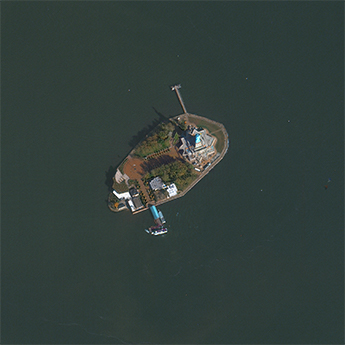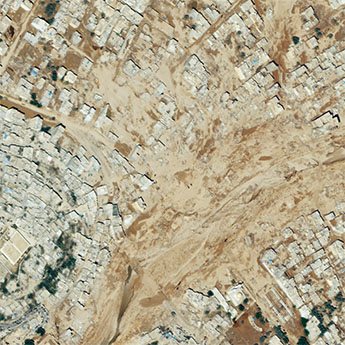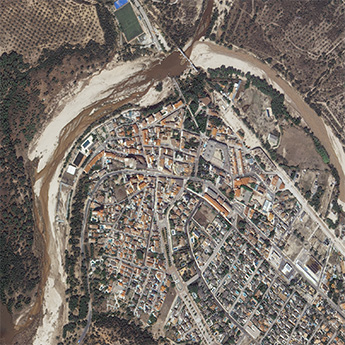활용사례
| 제목 | Radiometric Calibration and Uncertainty Analysis of KOMPSAT-3A Using the Reflectance-Based Method | ||
|---|---|---|---|
| 국/내외 | 국내 | 작성일 | 2020-05-07 |
|
In recent years, Korea has sustained consistent access to remote sensed data by launching Korea Multi-Purpose Satellite-3A (KOMPSAT-3A, K3A)—an updated version of the high-resolution KOMPSAT series. This KOMPSAT-3A required calibration and validation (Cal/Val) before and after its launch to enable proper functional characterization and to maintain the veracity of data collected. The Korea Aerospace Research Institute (KARI) executed the initial prelaunch calibration in the laboratory and we performed the Cal/Val of KOMPSAT-3A during the Launch and Early Operation Phase (LEOP) in the field. Two suitable sites in Korea and Mongolia with stable weather, almost uniform terrain, and near Lambertian diffusion, provided the necessary tarp reflectance to calculate the absolute radiometric calibration coefficients. The surface reflectance was determined using 12 and four well-calibrated reference reflectance tarps employing the FieldSpec® 3(Analytical Spectral Devices Inc., Boulder, CO, USA) Spectroradiometer. Subsequently, the top of atmosphere (TOA) radiance was estimated using radiative transfer code (RTC) software based on the Atmospheric and Topographic Correction (ATCOR). In addition, cross calibration was simultaneously performed at the Libya-4 pseudo invariant calibration site (PICS) for KOMPSAT-3A TOA radiance, using the spectral band adjustment factor (SBAF) compensated Landsat 8 reflectance and the Second Simulation of Satellite Signal in the Solar Spectrum (6S) to compute cross calibration coefficients. The results of the KOMPSAT-3A absolute calibration coefficient show that the R2 values were over 0.99, implying a significant correlation for almost all bands between the TOA radiance and the KOMPSAT-3A spectral band response at both campaign sites. However, this study reveals a difference of less than 5% calibration gains for all bands compared to the prelaunch values, while the cross calibration gain is below 5% in visible bands and above 5% in the near infrared band. An effort to optimize the reliability of the absolute calibration coefficients resorted to the rigorous quantification of uncertainties amongst atmospheric conditions, the digital number (DN), the reflectance tarp, the bidirectional reflectance distribution function (BRDF), and ozone levels. Therefore, we presumed that the total uncertainty was 4.27%, which conforms to some published results. |
|||
| 출처 | Sensors | ||
| 이전글 | Rigorous Co-Registration of KOMPSAT-3 Multispectral and Panchromatic Images for Pan-Sharpening Image Fusion |
|---|---|
| 다음글 | RadCalNet 자료를 이용한 다목적실용위성 3A 영상 자료의 지표 반사도 성과 검증 |
연관위성영상
-
 미국:자유의 여신상(2023-11-03)
미국:자유의 여신상(2023-11-03)2023-11-14
-
 리비아:데르나 홍수(2023-09-13)
리비아:데르나 홍수(2023-09-13)2023-09-18
-
 스페인:홍수(2023-09-06)
스페인:홍수(2023-09-06)2023-09-14
연관활용사례
-
SSResUnet 모델을 이용...
토양
2024-04-19
-
Wildfire in Chile
재해
2024-04-04
-
KOMPSAT-3A 영상에 대...
지리
2024-04-04
최신미디어
-
항우연
항우연, 심우주탐사를 위...
2024-03-14
-
항우연
대한민국 최초 달 궤도선...
2024-03-14

네팔:지진(2015-05-05)
| 카테고리 | 재난재해 |
|---|---|
| 위성정보 | KOMPSAT-3 |
| 생성일 | 2015-03-24 |
세부정보
| ProductID | K3_20150505073608_15817_06161210 |
|---|---|
| 국가(영문) | Nepal |
| 국가 | 네팔 |
| 지역 | Pokhara |
| 레벨 | 1R |


